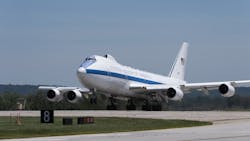L3Harris to upgrade SSHF satellite communications for E-4B airborne command post to control nuclear forces
WRIGHT-PATTERSON AFB, Ohio – U.S. Air Force strategic communications experts needed a company to upgrade the survivable super high frequency (SSHF) satellite communications systems aboard the E-4B Advanced Airborne Command Post. They found their solution from the L3Harris Technologies Communications Systems West segment in Salt Lake City.
Officials of the Air Force Life Cycle Management Center at Wright-Patterson Air Force Base, Ohio, announced a $23.8 million contract to L3Harris on Thursday to perform survivable super high frequency (SSHF) satellite communications (SATCOM) upgrades to the E-4B aircraft.
The Air Force E-4B represents a fleet of four modified Boeing 747-200 jumbo jets that serve as survivable mobile command posts for the president of the United States, the U.S. secretary of defense, and other U.S. national command authorities.
When airborne, the E-4B operates as a national airborne operations center to enable national command authorities to maintain control over military conventional and nuclear forces if more conventional means of command and control have been destroyed or disabled from war damage or other disasters.
The E-4B's SSHF upgrades will improve and replace portions of the E-4B's SHF system to ensure continued connectivity and interoperability as satellite and communications infrastructure evolves.
Expected modifications include component and subsystem upgrades and replacement of portions of the current SHF system that are obsolete or near end of service life.
A replacement to the E-4B's SSHF system eventually will be necessary as secure and survivable communications capability switches from the Defense Satellite Communications System (DSCS) to the future Wideband Global (WGS) SATCOM system.
While DSCS provides data transmission speeds as fast as 200 megabits per second, the WGS features data rates ranging from 2.1 to 3.6 gigabytes per second. Fourteen DSCS satellites were launched between 1982 and 2003, with eight of them still working. Ten WGS satellites have been launched between 2007 and 2019.
The E-4B aircraft is a survivable, command, control, and communications center to direct U.S. forces, execute emergency war orders, and coordinate civil authorities' activities, including national contingency plans.
The E-4B aircraft also has a low-frequency transmit system (LFTS) to send instructions to submerged ballistic missile submarines. The LFTS can transmit signals as strong as 100 kilowatts over low frequencies of 28 to 60 KHz -- lower frequencies than commercial AM broadcast radio -- to send encrypted text messages to submerged submarines.
The E-4B also maintains contact with other nuclear forces via advanced extremely high frequency (AEHF) SATCOM and other secure communications systems.
On this contract L3Harris will do the work in Salt Lake City and Offutt Air Force Base, Neb., and should be finished by April 2022. For more information contact L3Harris online at www.l3harris.com.
About the Author
John Keller
Editor-in-Chief
John Keller is the Editor-in-Chief, Military & Aerospace Electronics Magazine--provides extensive coverage and analysis of enabling electronics and optoelectronic technologies in military, space and commercial aviation applications. John has been a member of the Military & Aerospace Electronics staff since 1989 and chief editor since 1995.
